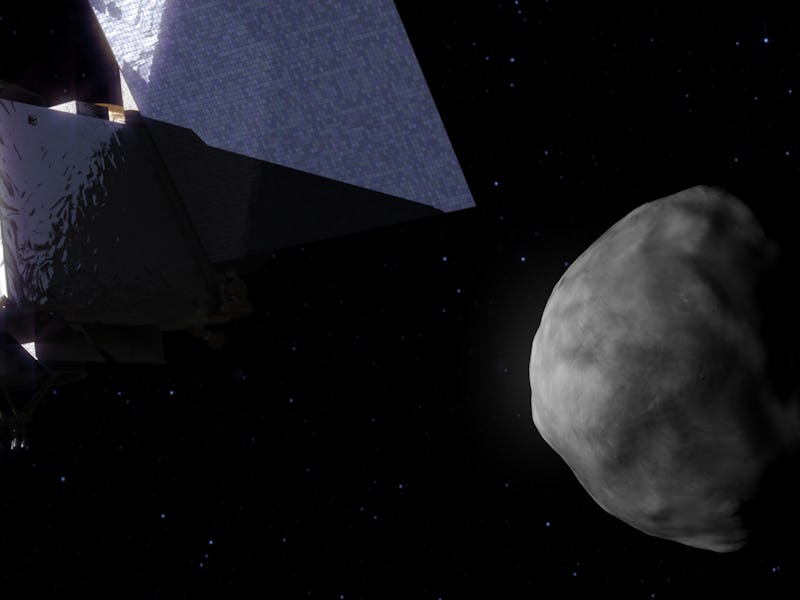The Asteroid Determining Earth's Future — and Humanity's Past
OSIRIS-REx has the potential to change the course of space exploration.

KENNEDY SPACE CENTER, FL — An otherwise non-descript probe sits at NASA’s Payload Hazardous Servicing Facility (PHSF) as it undergoes final inspection before its terrestrial departure next Thursday, September 8. But this probe — the mythologically named OSIRIS-REx — might change the course of space travel and the future of our planet.
OSIRIS-REx is an acronym for Origins Spectral Interpretation Resource Identification Security Regolith Explorer. It’s an impressive name for a probe with a more-than-impressive mission that’s the stuff of movies: OSIRIS-REx will land on a speeding asteroid — Bennu — for samples, then return to Earth to see what future asteroids will have for future space exploration.
Bennu is just one of 7,000 asteroids slinging through space at top speeds near Earth. They’re not just pieces of rock; they’re carbon-rich and full of potentially precious metals, holding not only the secrets to the history of our 4-billion-year-old solar system but — if Armageddon is any indication — capable of tumbling into Earth and ending life as we know it.
NASA isn’t hiding the fact that it’s viewing this mission as a potential way to prepare for a potential future involving life-ending catastrophes from asteroids pummeling to the planet and creating either dust storms or earthquakes or typhoons or all of the above, and then some, said Jeffrey Grossman, a scientist with OSIRIS-REx.
“It’s going to inform our understanding for the potential for life in the solar system; on Earth and elsewhere. But it also advances our more practical goals of understanding the resources of the near-Earth solar system, as well as the hazards; characterizing those, and better understanding the processes that are involved with those [hazards].”
It’s for these reasons — the possibility of understanding whether we have extraterrestrial friends or whether we’re due for an asteroid disaster — that makes the OSIRIS-REx mission that much more important, perhaps one of the most important of 2016. Bennu — named after the Egyptian mythological bird — is roughly 500 meters in diameter. It was chosen for its size, chemical makeup, and orbital proximity to our planet. But what makes Bennu most interesting to NASA isn’t just that it’s a large asteroid; every six years, Bennu swings within 0.002 AU (astronomical units, or the average distance between the Earth and Sun). The moon, for comparison, is 0.002454 AU from Earth.
Which means Bennu the Asteroid gets disturbingly, frighteningly close to being able to destroy life as we know it on our planet.
It might not be within our lifetime, but we’re kinda due for an asteroid shelling our home planet. OSIRIS-REx Principal Investigator Dante Lauretta pointed out during a press conference at NASA’s PHSF, “that 2135 fly-by is going to tweak Bennu’s orbit, potentially putting it on course for the Earth later that century.” And while the asteroid may not be on the list of globally-catastrophic sized space rocks, it certainly wouldn’t simply burn up in the atmosphere. An impact from an asteroid of Bennu’s size could easily devastate a metropolitan area for miles.
The “Security” title in the OSIRIS-REx acronym holds the focus to this aspect of the probe’s mission. Bennu’s orbit has been observed in close detail since 1999, and while scientists have a theory for the forces that can influence the asteroid’s orbit, data from OSIRIS-REx will allow the refinement of current models and measurements used to track the orbits of such planetary bodies.
Known as the Yarkovsky effect, an asteroid absorbs solar radiation during its natural rotation relative to the Sun, then expels that heat like a radiator as thermal radiation. This expulsion creates a minuscule, but impactful force of thrust as the asteroid spins that can alter its orbit over time.
Lauretta explains, “The Yarkovsky effect turns out to be a fundamental process that’s affecting these small asteroids across our solar system…The asteroids get their energy from the Sun. A lot of that energy, especially on a dark asteroid like Bennu, is absorbed, causing the asteroid’s surface to heat up. It has to release that energy back out into space, and when that happens, it acts like a thruster and changes the trajectory of the asteroid. So if you want to predict where an object like Bennu is going to be in the future, you have to account for this phenomena. And we’re going to provide the best ever scientific investigation of this fascinating concept.”
One might wonder, if the small amount of thrust caused by the Yarkovsky effect is enough to potentially put Bennu’s trajectory on a collision course with Earth, how will it be affected by a spacecraft bumping into it and releasing a burst of pressurized gas? Thankfully, Lauretta was quite reassuring.
“I have full confidence in the astrodynamics team, who have calculated the force profile and the trajectory of the asteroid, and assured me that we will not substantially influence the orbit and send it onto an impact trajectory with the Earth.”